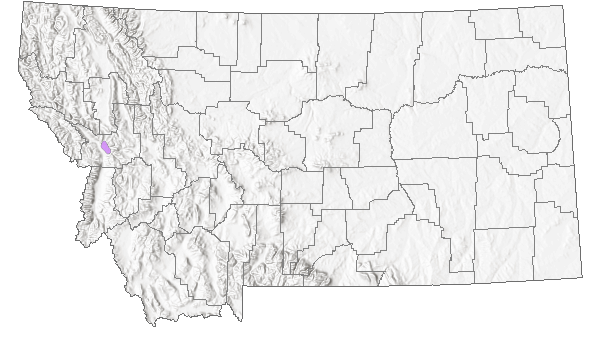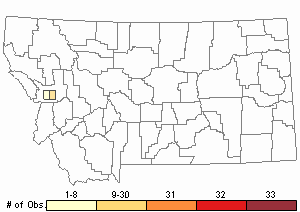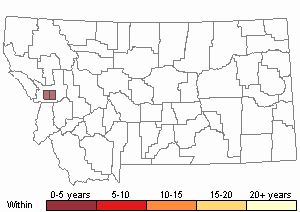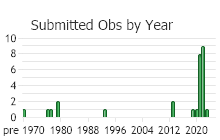View in other NatureServe Network Field Guides
NatureServe
Montana
Utah
Wyoming
Idaho
Wisconsin
British Columbia
South Carolina
Yukon
California
New York
Missoula Phlox - Phlox missoulensis
Other Names:
Phlox missoulensis, Phlox kelseyi var. missoulensis
State Rank Reason (see State Rank above)
Missoula phlox is a state endemic known from over 2 dozen occurrences in west-central Montana, most of which are moderate to large-sized. Populations occur on a mix of ownerships, including private lands which host several occurrences. The Waterworks Hill population is infested with several noxious weeds and heavy recreational trail use also occurs within the occupied habitat. Other populations appear to be at much less risk though some impacts from invasive weeds, recreational use and development are possible.
- Details on Status Ranking and Review
Population Size
Score1 - Moderate: Generally 10,000-100,000 individuals.
Range Extent
Score2 - Regional or State Endemic or Small Montana Range: Generally restricted to an area <100,000 sq. miles (equivalent to 2/3 the size of Montana or less) or Montana contributes 50% or more of the species’ range or populations OR limited to 2-3 Sub-basins in Montana.
Area of Occupancy
Score1 - Moderate: Generally occurring in 11-25 Subwatersheds (6th Code HUC’s).
Environmental Specificity
Score1 - Moderate: Species is restricted to a specific habitat that is more widely distributed or to several restricted habitats and is typically dependent upon relatively unaltered, good-quality habitat (C Values of 5-7).
Trends
Score1 - Minor Declines: Species has experienced declines of 10-30% in population size, range extent and/or occupied area in the recent past (approximately 30 years).
CommentTrends are undocumented at most sites. The species is likely stable at most locations with some declines at a couple of the low elevation sites.
Threats
Score2 - High: 31-70% of the populations are being negatively impacted or are likely to be impacted by one or more activities or agents, which are expected to result in decreased populations and/or habitat quality and/or quantity.
CommentInvasive species are a primary threat to the low elevation populations. Trampling has been a threat to one population, though the trail has been re-routed around the population greatly reducing the likelihood of this iimpact occurring.
Intrinsic Vulnerability
Score0 - Low Vulnerability: Species does not have any unusual or specific life history or biological attributes or limted reproductive potential which makes it susceptible to extirpation from stochastic events or other adverse impacts to its habitat and thus slow to recover.
Raw Conservation Status Score
Score
8 total points scored out of a possible 19.
General Description
Missoula Phlox is a mat-forming perennial with numerous prostrate, branching stems that are up to 10 cm long and arising from a branched rootcrown. The sharply-pointed, linear leaves are 10-25 mm long and 1-3 mm wide, are opposite each other on the stem, and have thickened margins and long, spreading hairs at their base. The herbage is otherwise glabrous to short-hairy or glandular. The typical phlox flowers are solitary at the ends of the stems. The five-lobed calyx is densely hairy and sometimes glandular. The corolla is white or various shades of pink and blue. It has a tube that is 10-13 mm long and five broad lobes that are 6-9 mm long at the mouth. The style is 4-8 mm long.
Phenology
Flowering in May-June.
Diagnostic Characteristics
Phlox is a very difficult genus to distinguish, and a technical key should be consulted for positive identification. P. kelseyi var. missouliensis and P. kelseyi var. kelseyi are very similar; however, the former occurs in dry, exposed habitats, while the latter is found in moist meadows. P. multiflora, P. hoodii and P. pulvinata are also very similar in appearence.
Species Range
Montana Range
Range Descriptions

 Native
Native
Range Comments
Montana endemic, restricted to Missoula to the Little Belt Mountains and the southern end of the Rocky Mountain Front south to Granite County.
Observations in Montana Natural Heritage Program Database
Number of Observations: 38
(Click on the following maps and charts to see full sized version)
Map Help and Descriptions
Relative Density

Recency



 (Observations spanning multiple months or years are excluded from time charts)
(Observations spanning multiple months or years are excluded from time charts)
Habitat
Open, exposed, limestone-derived slopes in the foothills to exposed ridges in the subalpine zone.
Ecological Systems Associated with this Species
Ecology
POLLINATORS The following animal species have been reported as pollinators of this plant species or its genus where their geographic ranges overlap:
Bombus vagans,
Bombus flavifrons,
Bombus melanopygus,
Bombus pensylvanicus,
Bombus bimaculatus,
Bombus griseocollis,
Bombus impatiens, and
Bombus kirbiellus (Shaw and Taylor 1986, Colla and Dumesh 2010).
References
- Literature Cited AboveLegend:
 View Online Publication
View Online Publication Colla, S.R. and S. Dumesh. 2010. The bumble bees of southern Ontario: notes on natural history and distribution. Journal of the Entomological Society of Ontario 141:39-68.
Colla, S.R. and S. Dumesh. 2010. The bumble bees of southern Ontario: notes on natural history and distribution. Journal of the Entomological Society of Ontario 141:39-68. Shaw, D.C. and R.J. Taylor.1986. Pollination ecology of an alpine fell-field community in the North Cascades. Northwest Science 60:21-31.
Shaw, D.C. and R.J. Taylor.1986. Pollination ecology of an alpine fell-field community in the North Cascades. Northwest Science 60:21-31.
- Additional ReferencesLegend:
 View Online Publication
View Online Publication
Do you know of a citation we're missing? Campbell, L.M. 1992. Biosystematics of Phlox kelseyi (Polemoniaceae). M.S. thesis. University of Montana. 78 pp.
Campbell, L.M. 1992. Biosystematics of Phlox kelseyi (Polemoniaceae). M.S. thesis. University of Montana. 78 pp. Lackschewitz, K. 1991. Vascular plants of west-central Montana--identification guidebook. U.S. Forest Service Intermountain Research Station, Ogden, UT. 648 pp.
Lackschewitz, K. 1991. Vascular plants of west-central Montana--identification guidebook. U.S. Forest Service Intermountain Research Station, Ogden, UT. 648 pp. Lesica, P., M.T. Lavin, and P.F. Stickney. 2012. Manual of Montana Vascular Plants. Fort Worth, TX: BRIT Press. viii + 771 p.
Lesica, P., M.T. Lavin, and P.F. Stickney. 2012. Manual of Montana Vascular Plants. Fort Worth, TX: BRIT Press. viii + 771 p. Lesica, P., M.T. Lavin, and P.F. Stickney. 2022. Manual of Montana Vascular Plants, Second Edition. Fort Worth, TX: BRIT Press. viii + 779 p.
Lesica, P., M.T. Lavin, and P.F. Stickney. 2022. Manual of Montana Vascular Plants, Second Edition. Fort Worth, TX: BRIT Press. viii + 779 p. Locklear, J.H. 2009. Nomenclatural innovations in Phlox (Polemoniaceae), with updated circumscription of P. caespitosa, P. douglasii, P. missoulensis, and P. richardsonii. Journal of the Botanical Research Institute of Texas 3:645-658.
Locklear, J.H. 2009. Nomenclatural innovations in Phlox (Polemoniaceae), with updated circumscription of P. caespitosa, P. douglasii, P. missoulensis, and P. richardsonii. Journal of the Botanical Research Institute of Texas 3:645-658. Schassberger, L.A. and P.L. Achuff. 1991. Status review of Phlox kelseyi var. Missoulensis. Prepared for the USDA Forest Service, Region 1, Lewis & Clark National Forest, Montana. Montana Natural Heritage Program, Helena, MT 37 pp.
Schassberger, L.A. and P.L. Achuff. 1991. Status review of Phlox kelseyi var. Missoulensis. Prepared for the USDA Forest Service, Region 1, Lewis & Clark National Forest, Montana. Montana Natural Heritage Program, Helena, MT 37 pp.
- Web Search Engines for Articles on "Missoula Phlox"





